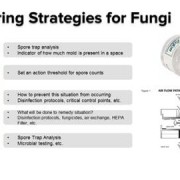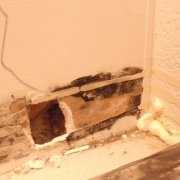Penicillium
An allergenic form of mold. It is easily recognizable by its characteristic blue or green colored surface with a velvety texture. Penicillin mold is often found in water damaged homes and buildings. It is found in materials such as carpets, wallpapers, ducting and even in mattresses. It spreads quickly from one area of the home to the next.Unfortunately, though penicillin is responsible for important antibiotic production and food processing capabilities, it is also the cause of terrible respiratory conditions when it grows indoors.
Penicillin spores can easily become airborne and travel through the home and can be inhaled by occupants, including pets and children. Penicillin exposure can cause pulmonary inflammation and asthma. When exposed to it for a longer time, it can lead to chronic sinusitis. People with immune disorders should not be exposed to penicillin as a penicillin infection can worsen symptoms and lead to further health complications.
Because penicillin mold growth is commonly associated with damp and moist areas, it is critical to remedy any household leaks or water damage as soon as possible to prevent penicillin from recurring and spreading throughout your home.
 Penicillium species are common contaminants on various substances. This organism causes food spoilage, colonizes leather objects and is an indicator organism for dampness indoors. Some species are known to produce mycotoxins. The health of occupants may be adversely affected in an environment that has an amplification of Penicillium.
Penicillium species are common contaminants on various substances. This organism causes food spoilage, colonizes leather objects and is an indicator organism for dampness indoors. Some species are known to produce mycotoxins. The health of occupants may be adversely affected in an environment that has an amplification of Penicillium.
Penicilliumis characterized by rapidly growing colonies having conidial structures resembling brushes. It commonly produces a strong musty odor. Penicillium marneffei is the only species of the genus that has a yeast-like phase induced by temperature. This can make it more difficult in irradiating it when an infection incurs, but not always impossible.

Penicillium Stachybotrys growing on wallboard (above)
Growth Media
Commonly found in soil, food, cellulose and grains. It is also found in paint and compost piles. It is also commonly found in carpet, wall paper, and in organic substances inside interior fiberglass duct insulation (NC). Some species can produce mycotoxins common cause of extrinsic asthma (immediate-type hypersensitivity: type I). Acute symptoms include edema and bronchi spasms, chronic cases may develop pulmonary emphysema. Many patients complain of a suffocating or gasping sensation when suffering from the effects of penicillium toxicity. But unfortunately, these are also the after effects of many other toxigenic molds.
Penicillium is one of the first fungi to grow on water-damaged materials and has been implicated in causing allergic reactions, hypersensitivity pneumonitis, and a variety of severe lung complications. It may cause sarcoidosis, fibrosis, or allergic alveolitis in susceptible individuals, or patients who have been exposed over long periods of time, depending on the strain.
Toxin Production
Penicillium Aurantiogriseum produces mycotoxins that when ingested or inhaled in large quantities, can cause considerable harm to humans and other mammals. Exposure to large spore loads is to be avoided at all costs. There are a number of toxins reported to be produced by this fungus, and are detailed as follows:
The neurotoxin verrucosidin is produced by this fungus. This toxin was associated with a neurological disease in cattle in the USA (J. Amer. Vet Med. Assoc. 179: 480-81,1991). The mycotoxin penicillic acid is also produced by this organism. Although nephrotoxins, which would cause liver and kidney damage, have been reported to be produced by this mold, the reports may have misidentified the mold. Both cyclopiazonic acid and penicillic acid produced by this mold have acute toxic effects on mammals , and it can be assumed that these mycotoxins are the casual agents of liver and kidney lesions in mice fed with contaminated corn.
Further products include ergosterol and the tremorgenic metabolites tremortin A and B and tremorgen. This mold is further known to produce tropolones puberulic acid and puberulonic acid, a mycotoxin of unknown structure, and a -(L)-malic acid that acts as a proteinase inhibitor. As with all toxigenic fungi, exposure to penicillium does alter human DNA and can cause permanent neurological, pathological, immunological and psychological damage.
Penicillium marneffei produces many serious infections that can be focal or disseminated that can affect the bone marrow, kidneys, lungs, intestines, liver, spleen, skin, and soft tissue. The clinical manifestations most commonly associated withPenicillium marneffeiare fever, weight loss, anemia, skin lesions, cough, hepatomegaly, adenopathies, and pulmonary infiltrates.
Apparently, several points of entry are possibly for Penicillium marneffei. The skin, inhalation, and all points of the digestion tract.
Common traits among Penicillium marneffei infected individuals is who have either traveled to and from Southeast Asia and Indonesia, where this fungus is epidemic; and individuals who have been exposed to Penicillium marneffeiin water damaged buildings. This fungal pathogen is unique among Penicillium species as it is the only one to demonstrate a temperature-dependant dimorphic growth stage. A yeast-like dimorphic phase occurs in human tissue and in temperatures at 37C degrees, while at 24C degrees the mycelial phase, which can be quite helpful in devising a plan of action as far as treatments are concerned.
| Clinical features | Percentage of cases |
| Fever | 99% |
| Anemia | 78% |
| Weight changes | 76% |
| Skin lesions | 71% |
| Lymphadenopathy | 58% |
| Hepatomegaly | 51% |
| Pulmonary disease/symptom | 49% |
| Diarrhea | 31% |
| Splenomegaly | 16% |
| Oral lesion | 4% |
For treatment, symptoms, and more information see www.mold-survivor.com
Suggested Reading / Abstract
- Filtenborg O, Frisvad JC, Thrane U., 1990 The significance of yeast extract composition on metabolite production in Penicillium In: Samson RA, Pitt JI, eds. Modern concepts in Penicillium and Aspergillus Classification, New York: Plenum Press
- Flannigan B, Miller JD., 1994 Health implications of fungi in indoor environments-An overview In: Samson RA, Flannigan B, Flannigan ME, Verhoeff AP, Adan OCG, eds. Health implications of fungi in indoor air environment. 1th ed. Elsevier, Amsterdam.
- Forgacs J, Carll WT., 1962 Mycotoxicosis Adv Vet Sci
- Fung F, Clark R, Williams S., 1998 Stachybotrys, a mycotoxin-producing fungus of increasing toxicologic importance Clinical Toxicology
- Frisvad JC, Filtenborg O., 1990 Secondary metabolites as consistent criteria in Penicillium taxonomy and a synoptic Penicillium subgenus Penicillium In: Samson RA, Pitt JI, eds. Modern Concepts in Penicillium and Aspergillus Classification. New York: Plenum Press.
- Frisvad JC, Thrane U., 1987 Standardised High-Performance Liquid Chromatography of 182 mycotoxins and other fungal metabolites based on alkylphenone retention indices and UV-VIS spectra (Diode Array Detection) J Chrom
- Frisvad JC, Thrane U, Filtenborg O., 1998 Role and use of secondary metabolites in fungal taxonomy In: Frisvad JC, Bridge PD, Arora DK, eds. Chemical fungal taxonomy. New York: Marcel Dekker.
- Gravesen S, Frisvad JC, Samson RA., 1994 Microfungi Copenhagen: Munksgaard
- Gravesen S, Nielsen PA, Iversen R, Nielsen KF., 1999 Microfungal contamination of damp buildings-examples of risk constructions and risk materials Env Health Persp 107:Supplement 3.
- Gray, Dr. Michael, 2001 Mold, mycotoxins and Human Health
- Pitt JI., 1979 The genus Penicillium and its teleomorphic states Eupenicillium and Talaromyces London: Academic Press.
- Rayner RW., 1970 A mycological colour chart Kew: Commonwealth Mycological Institute. p 34, charts I and II
- Samson RA, Seifert KA., 1985 The ascomycete genus Penicilliopsis and its anamorphs In: Samson RA, Pitt JI, eds. Advances in Penicillium and Aspergillus systematics. New York: Plenum Press.
- Solms-Laubach HG., 1887 Penicilliopsis clavariaeformis, ein neuer javanischer Ascomycet Ann Jard Bot Buitenzorg 6:53-72


 Cannabisindustryjournal.com
Cannabisindustryjournal.com  ©Nathan Ballentine
©Nathan Ballentine  © American Federation of Government Employees Local 1237
© American Federation of Government Employees Local 1237 



